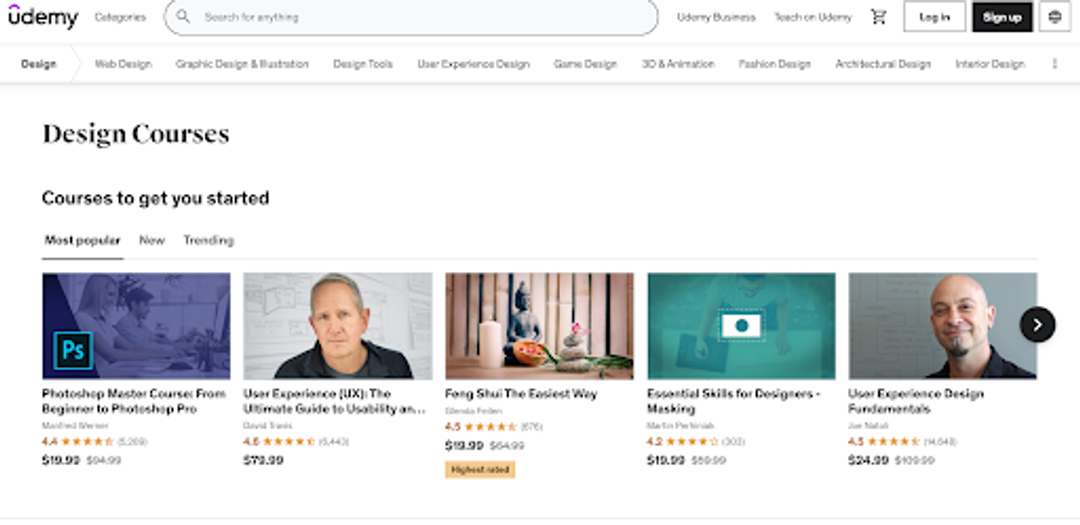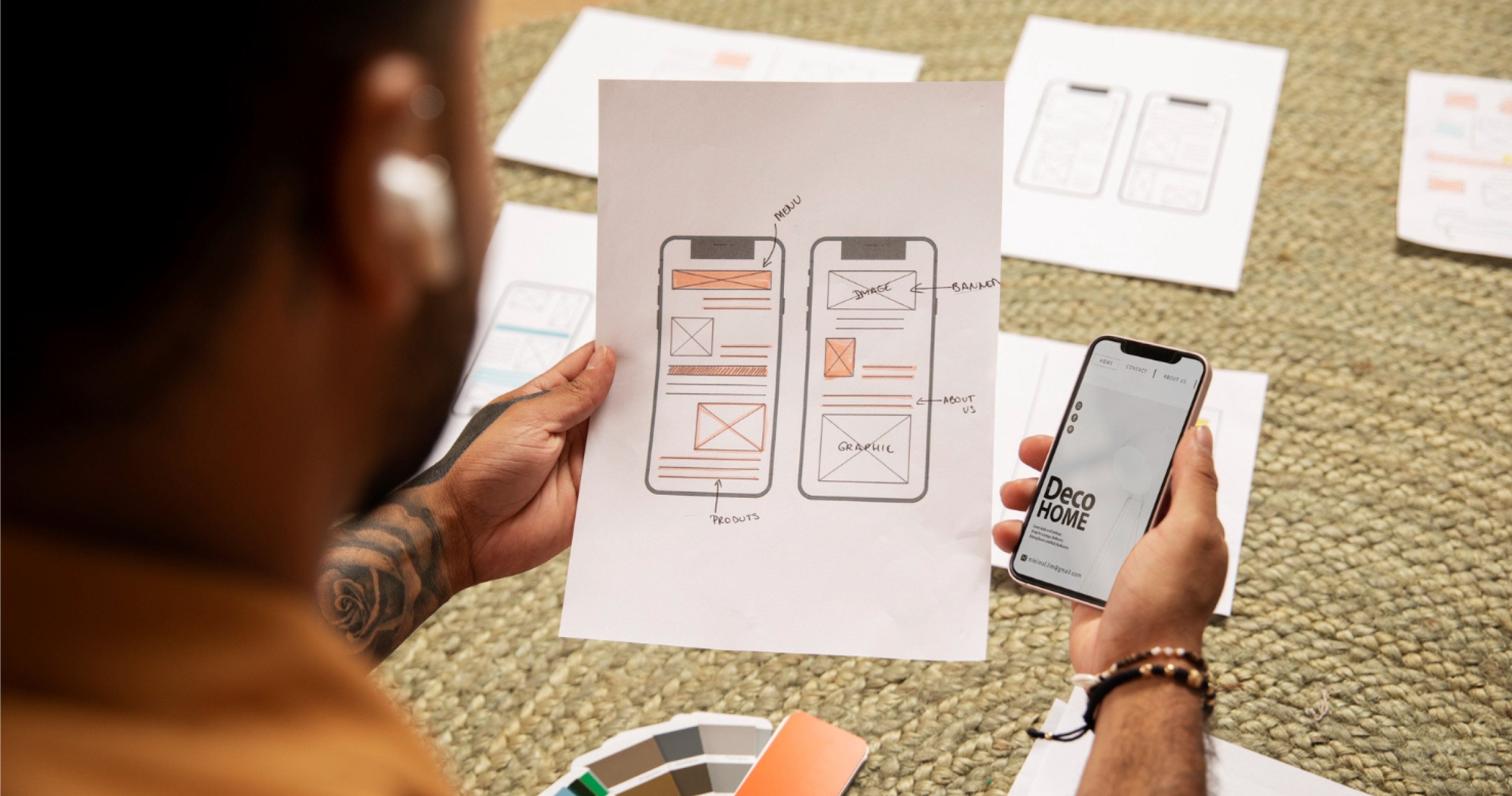The Growing Demand for UI/UX Designers
The demand for UI/UX designers has grown tremendously in the past decade alone. As technology advances at full-throttle speed, companies everywhere are starting to finally notice just how important user experience (UX) and interface design (UI) are when attempting to create killer products.
That being said, there has been a surge in demand for experts who possess specialized knowledge within this field.
According to the Bureau of Labor Statistics, between 2019-2029, the demand for these professionals is expected to grow by eight percent, which is considered faster than average compared to other occupations. As more businesses move towards digital transformation, they’ll need sharp employees who understand customer needs from start to finish and create designs that cater to them.
Source: Theme Photos on Unsplash

On top of that shift in mindset, many organizations are now using UX design to drive customer loyalty and increase sales.
Moreover, software and web development have become so complex that they require more specialized skills than ever before. Companies around the globe lean heavily on these designers in hopes they can create intuitive experiences. At the same time, users navigate through their systems —which might get complicated if you ask me…
So if you were looking for yet another sign telling you, “This is your calling,” then look no further; this is it. As the demand for UI/UX designers keeps increasing, so does the need for more talented individuals who can create unique designs that users will love. And with your dedication and a little motivation from us, we are confident you’ll be able to make it happen by 2024!
How to Become a UX Designer: Building a Foundation
Before getting into the nitty-gritty details of what steps you need to take to be a successful designer by 2024, let's first talk about building a strong foundation. You must have all your skills in check to prepare for such a competitive job search market.
Learning Design Principles
Color Theory and Psychology
When designing any product, color plays one of the most important roles because it has the power to influence user emotions, behavior, and thoughts. Understanding color theory will help designers like yourself use color effectively by examining its intricacies and relationships with each other.
In addition, psychology also plays an important part in understanding user behavior — which, as I said before, can be influenced by certain visual design choices. So a strong grasp of color theory and psychology can make or break your success as a UI/UX designer.
Source: Daniele Levis Pelusi on Unsplash

Typography and Fonts
Typography is vital for breaking up content sections and guiding users through navigation. That’s why UI/UX designers must deeply understand typography and fonts.
Layout and Composition
Layout and composition are critical UI/UX design elements that create an intuitive user experience. The right layout lets designers organize information clearly, so users can easily navigate the interface. It also creates visual hierarchies between elements that inform users how the interface works. Knowing how to use layout and composition is essential for any aspiring designer.
Source: Pankaj Patel on Unsplash

UI/UX Design Courses and Certifications
Online Platforms for Learning
1. Coursera
Coursera provides various courses and certifications for aspiring UI/UX designers. With courses from top universities and industry leaders, you’ll learn the skills necessary to become a professional graphic designer. Some popular classes include User Interface Design, UX Design Fundamentals, and Mobile App Design.
2. Udemy
Udemy also has a range of helpful courses for UI/UX beginners. They offer three classes covering all design aspects: UX Design Fundamentals, Mobile App Design, and User Interface Design.
Source: Udemy

3. LinkedIn Learning
LinkedIn Learning focuses on providing practical training to help you become a successful professional in almost any field—including computer science and UI/UX design. Their most popular class (and our recommendation) is UX Design Fundamentals.
4. Lynda
Lynda offers several comprehensive courses with different specializations in UI/UX design, such as Mobile App Design or User Interface Design; their offerings will teach you everything you need to know how to become UX designer and be successful in this field! Now a part of LinkedIn Learning.
Building a Portfolio for UI/UX Design
Projects and Design Process
Having the right UI/UX design skills is important, but it's not enough to land a job at any serious company. An impressive portfolio showcasing your skills is equally important when applying for UI/UX designer positions. Building projects show off your ability to apply those skills practically.
However, don’t just throw some examples on a few pages; call it done when putting together a portfolio. Show every step of the process – research, planning, wireframes, prototyping, usability tests. Demonstrate how you went through each one to get to the final product. This will let employers see that you know what you’re doing and have thought about user experience thoroughly.
Source: Anete Lūsiņa on Unsplash

Another way to clarify this point is by including any feedback or insights from users or customers regarding the products. For example, if you conducted surveys or interviews with customers about their experience using the interface and how they feel it could be improved in future iterations – put it in there! Also, show how you adjusted designs based on customer feedback since that will show an understanding of best practices and principles.
Finally, include creative elements used along the way, such as sketches, storyboards, and mood boards. Creative work can often be overlooked as simply “fluff,” but letting employers see this side of your work may help them understand your thinking process better!
By using these methods when applying for jobs as a UI/UX designer – projects and processes – your odds of getting hired improve significantly! Employers are looking for people who know what they’re doing here; having documentation to prove it will set you apart from other applicants.
Personal Projects and Case Studies
Coursework can only take students so far before personal projects become necessary for growth as designers. Personal projects allow them to experiment with new techniques or approaches. They can apply creativity and UX principles to make them more open to new ideas than client work allows.
Examples of personal projects may include designing applications or websites from scratch, re-designing existing ones, or experimenting with different user interfaces. Taking on personal projects lets designers progress at their own pace and learn new tools to help create better designs much faster!
Case studies are also valuable for a designer. It’s one thing to say you produced a successful interface design – another to prove it. By analyzing the successes and failures of past projects, other professionals can learn from your mistakes and improve their own skills significantly. When putting together case studies, explain user research, customer feedback, usability testing results, prototyping methods, decisions made during design processes, etc.
Freelancing and Internship Opportunities
For younger designers looking to start making money off their skills or those wanting an internship with a reputable company – a portfolio full of personal work is probably one of the most important things they can have right now. It shows potential employers how skilled you are and what goes through your mind when designing intuitive interfaces for them!
Freelancing and internships are great ways for UI/UX designers to gain experience. Freelancing allows young designers to work on shorter projects to build their portfolios without committing to jobs or challenging long-term projects. On the other hand, internships allow designers to learn more about the industry, get hands-on experience, and work with seasoned professionals who can guide them.
Source: Annie Spratt on Unsplash

Freelancing also offers a flexible work schedule that many people value. One could work as a freelancer from anywhere in the world and still be able to control when they work. On top of that, not having to commit to long-term contracts gives UI/UX designers a chance to diversify their experiences through clients from various industries.
Joining design communities and organizations is a smart move for those eager to keep learning even after landing an internship or freelancing gig. These communities allow designers to connect with others in the field and learn from professionals who have been there before them.
Networking and Professional Development
Joining Design Communities and Organizations
Designers can find job postings, mentor programs, workshops, conferences, competitions, and more by being part of these networks. Getting involved with these organizations will allow aspiring professionals to meet like-minded individuals with whom to collaborate for future jobs or projects.
Continuing education resources are also available within these professional groups, such as eBooks, tutorials, webinars, or online courses that help professionals stay up-to-date with trends while learning new skills. Some of these organizations may even offer certifications for UI/UX or graphic design experts looking to prove their worth in these fields.
By interacting with fellow ambitious individuals through forums or meetups organized by design communities, young creatives can share their work and receive feedback from peers. This sort of environment promotes individual growth and stronger relationships between colleagues.
Source: Dylan Gillis on Unsplash

UI/UX designers should take advantage of all available resources if they want solid portfolio pieces while keeping up with peers in the industry!
There are many ways for aspiring UI/UX designers to learn more about the industry and prepare themselves for a successful career. One of the most effective methods is attending design conferences and workshops that focus on specific areas of design.
Conferences
Design conferences like Interaction Design, SXSW, and UXPA are excellent opportunities for aspiring professionals to network with other people in the industry while learning from some of the best minds in the field. Conferences often feature lectures, workshops, and tutorials on various UI/UX design aspects. Additionally, these events allow designers to stay current on current trends and new technologies.
Workshops
Aspiring UI/UX designers can participate in workshops for a more hands-on approach to learning. Unlike conferences which offer a wide variety of topics, workshops are typically much more concentrated training sessions on one subject. These events give attendees direct instruction from experienced professionals who deeply understand what they’re teaching.
Source: Jaime Lopes on Unsplash

Attending design conferences or workshops will increase your chances of landing a job with an industry-leading company or even starting your own business!
Job Hunt and Career Path
Creating an Impressive Resume and Portfolio
To land a UI/UX design job, you’ll need to have two things: a killer resume and a portfolio. Resumes must show an understanding of user experience design along with a relevant skillset and experience. Being concise is important, but so is being comprehensive. Portfolios should provide employers with samples of the candidate’s work, proving their ability to solve design puzzles.
When creating a solid resume, candidates should craft them in a way that speaks to the job requirements while also highlighting their own strengths. Avoiding unnecessary information or jargon is crucial as well. Instead, focus on making your qualifications stand out from other applicants. Additionally, resumes should be tailored for each position applied for; this allows individuals to emphasize specific qualifications that are most pertinent to the job opening.
An effective portfolio can make or break your chances of landing your dream UI/UX designer job. That’s why designers must choose projects carefully and ensure they reflect their best work. The goal is for potential employers to see how well you can design through user experience. Each project should also explain the problem-solving techniques used during its creation. Was there anything particularly innovative about your approach? How did you contribute to past projects? Employers want answers to these questions before hiring someone! Lastly, everything in the portfolio must be perfect – right down to the very last detail – showing clients or employers how dedicated you are to making successful designs.
Overall, impressing future employers isn’t just about what shows up on paper or on-screen; it’s about showcasing professionalism through thoughtful resumes and portfolios filled with relevant projects!
Preparing for UI/UX Design Interviews
The interview portion of applying for a graphic design job can be nerve-wracking alone! However, taking time beforehand to research the company or organization you’re applying to will make things much easier. Knowing more about the culture and core mission of the place you’re applying for helps provide context for any questions answered during the interview. Each question should be thoughtfully considered and answered in a way that highlights how the applicant will contribute value to the organization.
Source: João Ferrão on Unsplash

When preparing for a UI/UX design interview, brushing up on industry-specific skills and knowledge related to user experience design is essential. Understanding key concepts such as accessibility, usability, interface design, prototyping techniques, user testing methods, etc., is essential in demonstrating one’s expertise and interest in the field. Employers often ask questions that test candidates’ technical proficiency, so having a strong background on relevant topics is always beneficial!
In addition, applicants should review common interview questions related to UI/UX design and practice answering them aloud or even role-playing such scenarios with a friend or colleague beforehand. This helps individuals gain confidence in an interview and allows them to become familiar with potential questions they may face during the meeting.
First and foremost, a successful interview involves being well-groomed. Dressing appropriately in business attire is essential. Arriving early— at least 10 minutes before the scheduled time— shows you're serious about this opportunity. Being courteous and polite is important. You mustn’t interrupt anyone while they are talking. When it comes to answering questions, a thorough yet concise response is what recruiters are looking for. Ask relevant follow-up questions when appropriate, showing genuine interest in the team or company. Lastly, send a follow-up note after the interview concludes, as it demonstrates appreciation and respect towards those who gave you their time.
Lastly, being well-groomed and professional on interview day is another crucial factor when making a good impression on potential employers. Candidates must dress appropriately (in business attire), arrive early (at least 10 minutes prior), be courteous and polite at all times (be sure not to interrupt anyone while talking), answer questions thoroughly yet concisely (avoid rambling on too long), ask relevant follow-up questions when applicable (show genuine interest in acquiring more information about the team or company) and follow-up after an interview has concluded (this shows your appreciation). Doing these things not only demonstrates respect towards those interviewing you but it also goes a long way in helping you stand out from other applicants!
Source: Christina @ wocintechchat.com on Unsplash

Read More
Conclusion
UX/UI design is a lot to take in. It’s like juggling, with a mix of technical skills, knowledge, and soft skills all while being on call 24/7. In order to be successful in UX/UI Design, it’s important to take advantage of professional opportunities. Internships or entry-level positions will give you the hands-on experience to build your portfolio.
Certification is another factor that can set you apart from other candidates during the hiring process. Acquiring a UX certification, for instance, will help boost your skillset and show employers that you're serious about your passion. Proper preparation will put you miles ahead, even if it's a hobby!


About Clay
Clay is a UI/UX design & branding agency in San Francisco. We team up with startups and leading brands to create transformative digital experience. Clients: Facebook, Slack, Google, Amazon, Credit Karma, Zenefits, etc.
Learn more

About Clay
Clay is a UI/UX design & branding agency in San Francisco. We team up with startups and leading brands to create transformative digital experience. Clients: Facebook, Slack, Google, Amazon, Credit Karma, Zenefits, etc.
Learn more




